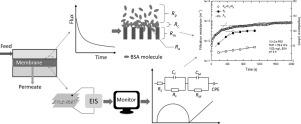Journal of the Taiwan Institute of Chemical Engineers ( IF 5.5 ) Pub Date : 2022-01-06 , DOI: 10.1016/j.jtice.2021.104197 Mai Lien Tran , Chun-Chieh Fu , Meng-Han Wu , Ruey-Shin Juang

|
Background
Fouling control and monitoring of the membranes during a pressure-driven separation process is critical for practical operation and applications.
Methods
In this work, a non-constructive technique electrical impedance spectroscopy (EIS) was applied to detect fouling development during crossflow ultrafiltration (UF) of bovine serum albumin (BSA) solutions using polyethersulfone and cellulose acetate membranes with a molecular weight cut-off of 10 kDa and 20 kDa, respectively. Various electrical impedances due to the electrolyte solution, the fouled layer, and the membrane itself were determined at different transmembrane pressures (68.9, 137.9, and 206.8 kPa), BSA concentrations (100, 500, and 1000 mg/L), and pH values (3.0, 5.0, and 8.6) based on a proposed equivalent circuit diagram. On the other hand, the filtration resistances due to the solute adsorption, concentration polarization, cake formation, and membrane itself were also determined according to a resistance-in-series model.
Significant findings
Correlations between the variations of various electrical impedances and filtration resistances with time were finally examined to justify the validity of EIS technique applied in crossflow UF processes. This work has verified from flux decline experiments that EIS was a powerful tool in monitoring fouling development in crossflow UF processes, particularly with a predominant contribution of the fouled layer resistance of to the overall transport.
中文翻译:

电阻抗光谱法对蛋白质溶液错流超滤实时污染分析的实验验证
背景
在压力驱动的分离过程中膜的污染控制和监测对于实际操作和应用至关重要。
方法
在这项工作中,使用非建设性技术电阻抗光谱 (EIS) 检测牛血清白蛋白 (BSA) 溶液在交叉流超滤 (UF) 过程中使用聚醚砜和截留分子量为 10 的醋酸纤维素膜的污垢发展。 kDa 和 20 kDa,分别。在不同的跨膜压力(68.9、137.9 和 206.8 kPa)、BSA 浓度(100、500 和 1000 mg/L)和 pH 值下,测定了由电解质溶液、污染层和膜本身引起的各种电阻抗(3.0、5.0 和 8.6)基于建议的等效电路图。另一方面,由于溶质吸附、浓差极化、滤饼形成和膜本身引起的过滤阻力也根据串联阻力模型确定。
重要发现
最后检查了各种电阻抗和过滤电阻随时间变化之间的相关性,以证明 EIS 技术在横流超滤工艺中应用的有效性。这项工作已从通量下降实验中证实,EIS 是监测错流超滤过程中结垢发展的有力工具,尤其是结垢层阻力对整体传输的主要贡献。









































 京公网安备 11010802027423号
京公网安备 11010802027423号